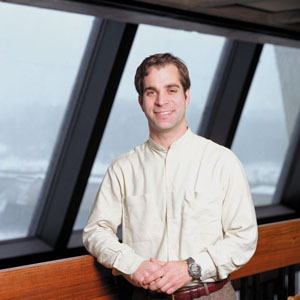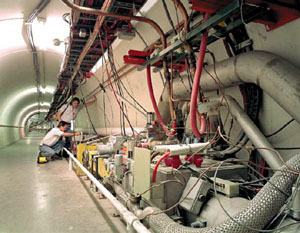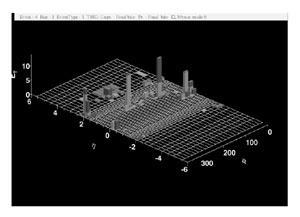After detecting hints of the long-awaited Higgs particle, CERN’s LEP electron-positron collider closed at the end of 2000 and is now being dismantled. The search for the Higgs – the missing link in today’s picture of particle physics – is now taken up by Fermilab’s Tevatron proton-antiproton collider, which has just begun a major new phase of operations. In this article, first published in Ferminews,* Mike Perricone sounds out the prospects.
Chris Tully made his first visit to Fermilab in 1988 as a high school student, representing the state of Virginia in the US Department of Energy’s national high school honours programme. He learned to string wires for the muon chambers at the D0 detector.

He returned 12 years later, on 13 December 2000, as a Fermilab Colloquium presenter, Princeton University physicist and CERN experimenter. This time he was reporting on the “tantalizing hints” for the Higgs mechanism that had shown up at CERN’s Large Electron-Positron (LEP) collider before the 8 November shutdown (seE Season of Higgs and melodrama).
Tully’s presentation echoed the global state of anticipation over the beginning of Collider Run II of the Tevatron – and the search for the origin of mass. “For eager Higgs hunters,” said Tully, “the immediate focus will be on the Run II results from Fermilab as the next possible source for direct evidence for the Higgs mechanism. Now that evidence suggests a low-mass Higgs, it might mean that Fermilab is in exactly the right place to observe a wealth of new physics.”
The whole world is watching, and the Higgs is far from being the only attraction as Fermilab opens Collider Run II of the Tevatron. In fact, Higgs candidates might not make an appearance for quite some time. CDF experiment co-spokesperson Franco Bedeschi estimates that five years of Run II would produce about 3000 Higgs candidates (out of 5 x 1014 proton-antiproton collisions) in the mass range of 115 GeV that is suggested by LEP results and other data.

So what else is new? Almost everything: new particles; new dimensions; new top quark measurements and production channels; and new CP violation results in B physics. “There is the possibility of finding something definitive early on,” said theorist Chris Hill. “For example, it’s possible that we will uncover a new layer of physics with new strong dynamics. That could show up in the first inverse femtobarn.”
Near the top of the Run II wish list is the top quark. Discovered at the Tevatron in 1995, the top is due for a step up in precision and a new production mode. Called single top production, the process starts with an up quark annihilating against a down quark (within the Tevatron’s proton-antiproton collisions). Out pops a “virtual” W boson, which quickly decays into a top and an antibottom.
“Single top production has never been observed before,” said Hill. He described it as a “new window into the top”, offering a view of how the top couples to the W boson. It also provides tests of the Standard Model and background for Higgs production.
Precision measurements of the masses of the top quark and the W also serve as constraints on the Higgs mass. “These precision electroweak tests use the top mass and the W mass in combination with other measurements to predict the Higgs mass,” Hill continued. “You then have the potential to define precisely where the Higgs ought to be, and check it with a discovery.”
In Run I, Fermilab produced a grand total of 150 top quarks. Run II, however, will yield thousands. The top is also a route into supersymmetry – the theory that all Standard Model particles have “superpartners.” But it’s a route with a twist.
“It seems to work in reverse,” Hill explained. “Because the top is heavy, many people expect its superpartner – the ‘stop’ – to be light. The production of a ‘top’ and an ‘antistop’ are possibilities, although the decay modes are very model-dependent: you have to determine what they’re decaying into. There are many possible channels, but ‘stop’ production is something people might expect in Run II.”

Fermilab discovered the fifth – “bottom” – quark in 1977. The field of B physics measures the behaviour of particles containing bottom quarks, known as B mesons. The decays of B mesons and their antimatter counterparts produce subtle differences that could go a long way towards explaining the universe’s preferential treatment of matter over antimatter, leading to life as we know it.
Here, the key quantity differentiating the decays is sinß, and the goal is to measure that quantity as accurately as possible. Fermilab’s Collider Detector Facility (CDF) collaboration set a new standard in sin2ß measurement with data from Collider Run I, establishing a value of 0.79 ± 0.4, which is consistent with Standard Model predictions of a large positive CP-violating asymmetry in this decay mode – in other words, a big gap between the behaviour of matter and antimatter.
Then along came the BaBar experiment at PEP-II, the electron-positron collider at the Stanford Linear Accelerator Center (SLAC) and the Belle experiment at the KEKB collider in Japan, which have recently reported more accurate results. “CDF will be very competitive,” said Hill. “When CDF is back up to speed, they’ll be able to address CP violation in the B system.”
Fermilab has a long history of offering up something extra, and this may be a bonus for Run II. Hope springs from luminosity, a measure of the number of collisions that the Tevatron can produce to light up the field with new discoveries, Higgs and otherwise.
“The big question is: can we get the integrated luminosity?” said veteran CDF experimenter Henry Frisch of Chicago. “If we make enough Higgs candidates, the newly upgraded detectors will definitely be capable of seeing them.”

The issue of making enough candidates applies to the entire range of Run II science. That puts the focus on Fermilab’s Beams Division, which performs the intricate task of creating antiprotons, “cooling” them into intense beams and colliding them with proton beams.
The Beams Division has a long and distinguished history of exceeding its goals. For example, the original design goal for the Tevatron collider luminosity was 1030/cm2/s, which corresponds to about 50 000 proton-antiproton collisions per second witnessed at each detector.
The Beams Division took that goal and exceeded it by a factor of about 16. It got to 1.6 * 1031, which corresponds to a collision rate of about 800 000/s. “Now we’re talking about something in the order of 10 to 20 times that number – as many as 10 to 15 million collisions per second,” Frisch stressed.
Luminosity holds the key to discoveries – specifically, integrated luminosity, or the number of total collisions over the course of the run. Frisch explained that the Higgs has an extremely small cross-section – physics-speak for the probability that a proton would actually produce a Higgs particle, or any specific particle under investigation. The equation in question is simple: (luminosity) x (cross-section) = collision rate, or number of events per second. Thus a small cross-section requires lots of luminosity to produce a significant number of observable events.

“The people in the Beams Division have always had wonderful ideas to get the luminosity up,” Frisch said. “We’re not yet running up against a ‘brick-wall’ limit set by physical law. Clever ideas, new techniques and a lot of hard work may well get us what we need.”
All this is happening against a background of pushing forward with the MINOS and MiniBooNE neutrino experiments; and of the lab’s continuing support for CERN’s LHC and its Compact Muon Solenoid detector.
“Looking from the outside,” said Chris Tully, perhaps wistfully, “the prospects for Run II at Fermilab are very promising if new physics is sitting just beyond what LEP was able to explore.”
*FermiNews is a biweekly magazine published by Fermilab’s Office of Public Affairs.





